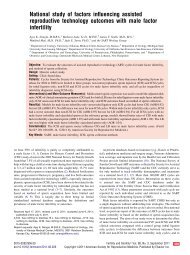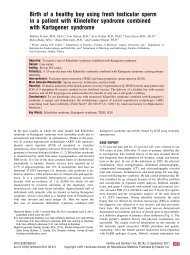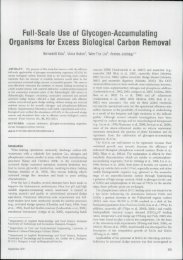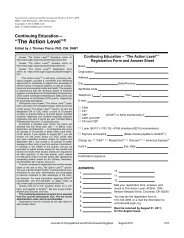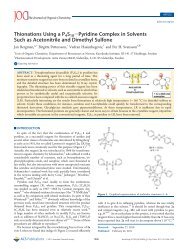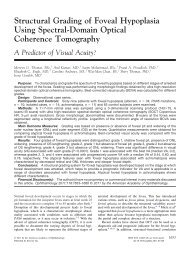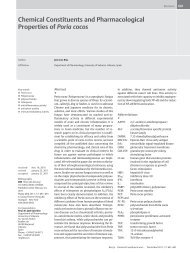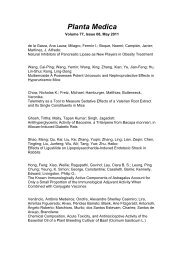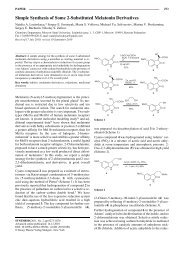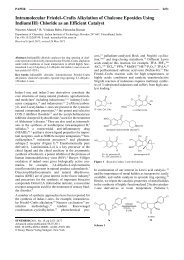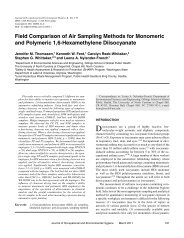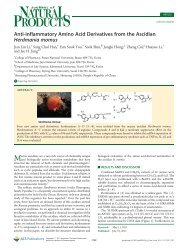Create successful ePaper yourself
Turn your PDF publications into a flip-book with our unique Google optimized e-Paper software.
716 J.-L. Zhu et al. PAPER<br />
between 2-cyano-3-methylbut-2-enoic acid ethyl ester (4)<br />
<strong>and</strong> the Danishefsky-type diene 5 could be used to create<br />
the A-ring <strong>of</strong> 1 <strong>and</strong> 2 in a single step with the concomitant<br />
introduction <strong>of</strong> the C-5 quaternary center <strong>and</strong> the C-1<br />
methyl group. In addition, the silyl enol ether moiety <strong>of</strong><br />
the resulting adduct 6 would be easily converted into the<br />
requisite enone functionality to afford the intermediate 7.<br />
After protecting the carbonyl group <strong>of</strong> 7, the cyano group<br />
would be elaborated into a but-3-enyl appendage through<br />
a reductive alkylation operation to give the intermediate 8.<br />
Then, the terminal vinyl moiety <strong>of</strong> 8 has to be changed<br />
into a keto functionality while the ester moiety has to be<br />
converted into a formyl group to afford the keto aldehyde<br />
9. Subsequent intramolecular aldol condensation <strong>of</strong> 9<br />
would allow the establishment <strong>of</strong> the spirocyclic core, by<br />
giving rise to intermediate 10. Finally, Wittig reaction<br />
<strong>of</strong> 10 with trimethylphosphonium bromomethylide<br />
(Ph 3P=CHBr) followed by the respective deprotection <strong>of</strong><br />
the resulting E- <strong>and</strong> Z-isomers would complete the total<br />
synthesis <strong>of</strong> 1 <strong>and</strong> 2.<br />
O<br />
9<br />
8<br />
1 <strong>and</strong> 2<br />
7<br />
EtO 2C CN<br />
10<br />
+<br />
OPG<br />
OTBS<br />
OHC<br />
EtO 2C<br />
OTBS<br />
5<br />
6<br />
4<br />
Scheme 2 Retrosynthetic analysis <strong>of</strong> 1 <strong>and</strong> 2<br />
In a modified procedure, our synthetic effort began with<br />
the condensation <strong>of</strong> ethyl cyanoacetate with acetone to<br />
provide the known compound 49 in 66% yield (Scheme 3).<br />
After this, the Diels–Alder reaction <strong>of</strong> 4 with diene 510 was carried out. It was observed that with the assistance <strong>of</strong><br />
zinc chloride, 4 could readily undergo the cycloaddition<br />
with 5 (5 equiv) in toluene at 80 °C, to afford the desired<br />
adduct 6 as a diastereomeric mixture (ortho-like, 50:50) in<br />
good yield (82%), together with the by-product 11 resulting<br />
from the self-addition <strong>of</strong> 5 (0.6 out <strong>of</strong> 5 equiv) as a single<br />
diastereomer. 11 As we designed, compound 6 should<br />
be directly transformed into enone 7, <strong>and</strong> for this purpose,<br />
two commonly employed reagent systems for converting<br />
silyl enol ether into enone, including 2,3-dichloro-5,6-dicyanobenzoquinone<br />
(DDQ)/benzene12a <strong>and</strong> Pd(OAc) 2/<br />
Na2CO3/MeCN, 12b were respectively attempted on 6 at<br />
different temperatures (r.t. to reflux). However, these reactions<br />
only led to recovered starting material or complex<br />
mixtures.<br />
We envisaged that the failure met with the transformation<br />
<strong>of</strong> 6 into 7 through the DDQ oxidation might be attributed<br />
Synthesis 2011, No. 5, 715–722 © Thieme Stuttgart · New York<br />
O<br />
9<br />
PG = protecting group<br />
CN<br />
OPG<br />
EtO 2C<br />
EtO 2C<br />
8<br />
CN<br />
7<br />
OPG<br />
O<br />
6<br />
2C CN EtO a<br />
66%<br />
c or d<br />
EtO2C<br />
2C 2<br />
EtO<br />
1<br />
4<br />
CN<br />
EtO2C<br />
b<br />
≡<br />
OTBS<br />
6 (50:50) (82%)<br />
OTBS<br />
H<br />
O EtO<br />
12<br />
Scheme 3 Reagents <strong>and</strong> conditions: (a) LiBr (5.0 equiv), MS 3Å,<br />
acetone, reflux, 18 h; (b) 5 (5.0 equiv), ZnCl2 (1.0 equiv), toluene, 80<br />
°C, 20 h; (c) LN (3.5 equiv), THF, –45 °C, 30 min, then<br />
H2C=CHCH2CH2Br (4 equiv), r.t., 24 h, 57% <strong>of</strong> 12; (d) LN (3.5<br />
equiv), THF, –45 °C, 30 min, then H2C=CHCH2CH2Br (4 equiv),<br />
HMPA (4 equiv), r.t., 12 h, 70% <strong>of</strong> 12.<br />
to the unfavorable electronic effect <strong>of</strong> the cyano group to<br />
the cation intermediate. In this regard, it was decided to<br />
reroute our original scheme by conducting the reductive<br />
alkylation <strong>of</strong> 6 first, to replace its cyano group with a but-<br />
3-enyl appendage. Following the previously established<br />
reaction conditions, 8 the reductive alkylation reaction was<br />
initially performed by treating 6 with LN (3.5 equiv) 13 in<br />
THF at –45 °C for 30 minutes, followed by trapping the<br />
resulting enolate from the reductive decyanation with 4bromobut-1-ene<br />
(4 equiv), affording the alkylated product<br />
12 in 57% yield as a single diastereomer. The trans steric<br />
relationship between C-1 butenyl <strong>and</strong> C-2 methyl groups<br />
was verified by 2D NOESY correlations as illustrated in<br />
Scheme 3. It was further discovered that a much better<br />
yield <strong>of</strong> 12 (70%) could be obtained by the use <strong>of</strong> hexamethylphosphoramide<br />
(HMPA) (4 equiv) as an activating<br />
reagent.<br />
With the cyano group having been replaced by the alkyl<br />
group, treatment <strong>of</strong> 12 with DDQ (5 equiv) in benzene at<br />
80 °C for 24 hours could indeed affect the formation <strong>of</strong> the<br />
enone moiety as evidenced by the low yield (~10%) <strong>of</strong> 13<br />
obtained. To improve the yield <strong>of</strong> 13, we continued to examine<br />
several reaction conditions by combining DDQ respectively<br />
with several bases, including K2CO3, 2,4,6collidine,<br />
14 <strong>and</strong> 2,6-lutidine, in benzene. Among the bases<br />
tested, the best result was obtained from the reaction <strong>of</strong><br />
DDQ (4.8 equiv) in 2,6-lutidine (5.1 equiv) affording 13<br />
in 55% yield (brsm: 72%), plus 30% <strong>of</strong> recovered 12<br />
(Scheme 4). Regarding the inherent instability <strong>of</strong> the<br />
enone, we thought that the carbonyl group <strong>of</strong> 13 should be<br />
protected before creating the B-ring. To this end, 13 was<br />
first reduced under the Luche’s conditions to give the allyic<br />
alcohol 14 in 79% yield as a diastereomeric mixture<br />
(76:24). The formation <strong>of</strong> two isomers in this case should<br />
O<br />
CN<br />
+<br />
11<br />
Me<br />
H<br />
H<br />
EtO2C<br />
OTBS<br />
OTBS<br />
H<br />
CN<br />
7<br />
O



